
E-mail: font@focusonnature.com
Phone: Toll-free in USA 1-888-721-3555
or 302/529-1876
 |
PO
Box 9021, Wilmington, DE 19809, USA E-mail: font@focusonnature.com Phone: Toll-free in USA 1-888-721-3555 or 302/529-1876 |
Part
3 of a List
with some Photos
of
South America
Butterflies
and Moths
Hairstreaks, Blues, Metalmarks
Noting those during
Focus On Nature Tours
in Argentina,
Brazil,
Chile,
Ecuador, Peru, Venezuela
Third Part of a List of South America Butterflies in
6 Parts,
compiled by Armas Hill
Here, in Part #3:
Lycaenidae, the Hairstreaks and Blues
and Euselasiinae and Riodinidae, the Metalmarks
Among Butterfly Groupings in this list, links to:
Hairstreaks:
Subfamily THECLINAE: with
the genera: Allomaitia, Apuecia, Arawasus, Arcas, Arumecla, Arzecla, Atlides, Aubergina,
Bistonina, Brangus,
Breviana, Busbiina, Calycopis, Camissecla, Celmia, Chalys, Chlorostrymon, Contrafacia, Copathecla,
Cyanophrys, Dicya, Eiseliana, Electrostrymon, Enos, Erora, Eumaeus, Evenus,
Exorbaetta, Gargina, Heoda, Hypostrymon, Iaspis, Ignata, Ipidecla, Janthecla, Johnsonita,
Kisulam, Kolana. Lamasina, Lamprospilus, Laothus, Lathecla, Magnastigma, Megathecla,
Micandra, Michaelus, Ministrymon, Mithras, Nesiostrymon, Nicolaea, Ocaria, Oenomaus, Olynthus, Ostrinotes, Paiwarria,
Panthiades,
Parrhasius, Penaincisalia, Phothecla, Podanotum, Porthecla, Pseudolycaena, Rekoa,
Rhamma, Salazaria, Semonina, Siderus, Strephonota,
Strymon, Symbiopsis, Temecia, Terenthina, Theclopsis, Theorema, Thepytus, Thereus,
Theritas, Thestius, Timaeta, Tmolus, Ziegleria
Blues: Subfamily POLYOMMATINAE: with
the genera: Echinargus, Hemiargus, Itylos, Leptotes, Madelinea, Nabokovia,
Pseuolucia, Zizula
Metalmarks:
Subfamilies
Euselasiinae & Riodinidae
Subfamily
EUSELASIINAE:
with the genera: Euselasia, Hades, Methone
Subfamily RIODININAE, Tribe HELICOPINI: with the genus: Helicopis
Subfamily RIODININAE,
Tribe MESOSEMIINI: with the genera:
Hermathena, Hyphilaria, Ithomiola, Leucochimona, Mesophthalma, Mesosemia, Napaea, Perophtalma,
Semomesia, Voltinia
Mesosemia and Seomesia are now said by some to be in the tribe RIODININI
Subfamily RIODININAE, Tribe EURYBIINI: with the genus: Alesa, Eurybia
Subfamily RIODININAE, Tribe RIODININI:
with the genera: Amarynthis, Ancyluris, Baeotis, Barbicornis, Brachyglenis, Calcodeta, Calophelis, Caria,
Cariomothis, Cartea, Chamaelimnas, Charis, Chorinea, Crocozona, Cyrenia, Detritivora,
Exoplisia, Ithomeis, Isapis, Lasaia, Lyroteryx, Melanis, Metacharis, Monethe,
Necyria, Netheme, Pheles, Paceella, Rhetus, Roeberella, Sysema,
Syrmatia
Subfamily RIODININAE, Tribe SYMMACHIINI:
with the genera: Calydna, Esthemopsis, Lucillella, Mesene, Mesenopsis, Panaropsis,
Pirascca, Symmachia, Xenandra, Xynias
Subfamily
RIODININAE.
Tribe NYMPHIDINI:
with the genera: Adelotypa, Anteros, Ariconias, Aricoris, Archaeonympha, Audre,
Calociasma, Calospila, Catocyclotis, Hypophylla, Juditha, Lemonias, Livendula,
Nymphidium, Ourocnemis, Periplacis, Rodinia, Sarota, Setabis, Stichelia,
Synargis, Theope, Thisbe
with genera having uncertain taxonomy as to tribe:
Argyrogrammana, Calydna, Comphotis, Echydna, Emesis, Imelda, Machaya, Pachythone,
Pseudotinea, Roeberella
Subfamily
RIODININAE,
Tribe STALACHTINI:
with the genus: Stalachtis
Subfamily RIODININAE,
Tribe unassigned:
genus Echydna
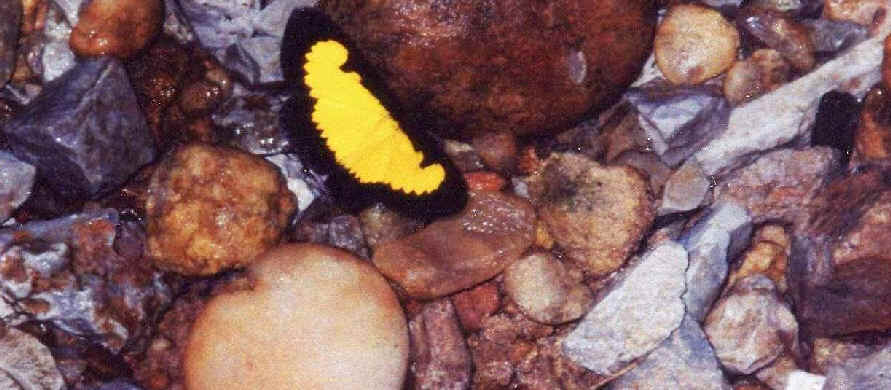
Not a butterfly, but a bright yellow and black
moth on stony ground in an Amazonian forest
during a FONT tour in Brazil.
The species is Xanthyris flaveolata, in the family Geometridae.
To see some photos of: MORE SOUTH AMERICAN MOTHS
Links to
other South America Butterfly groupings in this list:
Part #1 - Swallowtails (Papilionidae) Part #2 - Whites, Yellows, Sulphurs, Marbles (Pieridae)
Part #4 - Brushfoots (Nymphalidae)
Part #5 - Clearwings (Ithomiini) & Satyrs (Satyrini)
Part #6 - Skippers (Hesperlidae)
In South America, the
countries of Colombia, Peru, Brazil, and Ecuador each have a great
number of butterfly species.
Ecuador has the greatest concentration of species per kilometer. In that
country, there are said to be 2,726 species of butterflies.
Codes relating to illustrations
in various books:
Numbers noted as (AZ:xx)
refer to pages in "Butterflies of Arizona - A Photographic
Guide", by Bob Stewart, Priscilla Brodkin, & Hank Brodkin
(with fine photographs).
Numbers noted as (BB:xx) refer to pages
in "Butterflies of Buenos Aires (Argentina)", by Gustavo Canals
Numbers noted as (C:xx) refer to pages in
"A World of Butterflies", with text by Brian Cassie, and
photographs (superb) by Kjell Sandved
Numbers noted as (DA:xx) refer to pages in "Butterflies
of South America", by Bernard D'Abrera, 1984
Numbers noted as (DV1:xx)
refer to plates in "The Butterflies of Costa Rica and their
Natural History (Volume 1): Papilionidae, Pieridae, Nymphalidae", by
Philip J. DeVries
Numbers noted as (DV2:xx) refer to plates in
"The Butterflies of Costa Rica and their Natural History (Volume 2):
Riodinidae", by Philip J. DeVries.
Numbers noted as (EBE:xx) refer to pages
in "Ecuador's Butterfly Ecology", by Xavier Silva
Numbers noted as (F:xx) refer to pages
in "The Illustrated Encyclopedia of Butterflies", by Dr. John
Feltwell
Numbers noted as (K:xx) refer to pages
in the "Kaufman Focus Guide to Butterflies of North America", by
Jim Brock & Kenn Kaufman
Numbers noted as (MCA:xx)
refer to pages in "A Swift Guide to the Butterflies of Mexico &
Central America", by Jeffrey Glassberg
Numbers noted as (MM:xx) refer to pages
in "Mariposas (Butterflies) of Missiones (Argentina)", by
Gustavo Canals
Numbers noted as (PE:xx)
refer to plates in the "Peterson Field Guides to Eastern
Butterflies", by Paul Opler & Vichai Malikul, 1998 edition.
Those noted as (PEp:xx)
refer to a page with a photograph.
Numbers noted as (PW:xx) refer to plates
in the "Peterson Field Guide to Western Butterflies", by Paul
Opler & illustrated by Amy Bartlett Wright, 1999 edition.
Those noted as (PWp:xx)
refer to a page with a photograph.
Numbers noted as (RG:xx) refer to pages
in "Butterflies of the Lower Rio Grande Valley" by Roland Wauer.
Numbers noted as (S:xx)
refer to pages in the "Smithsonian Handbook, Butterflies
& Moths", by David Carter.
Country Codes:
AR: in Argentina
ba: province of Buenos Aires
ne: northeast Argentina,
including Iguazu Falls (ARne also
on the Brazilian side at Iguazu Falls)
BR: in Brazil
am: in the Amazonian region
mg: Mato Grosso, including the Pantanal
and north to Alta Floresta / Rio Cristalino
se: southeast Brazil
CH: in Chile
EC: in Ecuador
PE: in Peru
VE: in Venezuela
BUTTERFLIES OBSERVED DURING FONT TOURS NOTED BY AN (*) AFTER THE 2-LETTER
COUNTRY CODE.
(ph): species with a photo in the FONT website
Other Links:
Upcoming FONT Birding & Nature Tours
in South America in:
Brazil
Ecuador Uruguay Venezuela Argentina
Chile
Lists & Photo Galleries of BIRDS, including those during FONT Tours in South America
Lists & Photo Galleries of MAMMALS, relating to FONT Tours in South America
Alphabetical Directory of Butterflies by Genus of those with Photos in the FONT Website
Directory of Photos in this Website
Family LYCAENIDAE (GOSSAMER WINGS): including: HAIRSTREAKS, BLUES
Throughout the world but mostly in tropical and subtropical regions.
The
sexes often differ in coloration, and the undersides usually differ from the
upper surfaces.
Among several distinct groups are the
HAIRSTREAKS,
with tails and bright eyespot
markings on the hindwings, creating a "false head" at the rear, to
divert attackers.
Thus far, worldwide, about 5,000 species in this family have been discovered
and named.
Caterpillars of many of these species are closely associated with
ants.
Subfamily THECLINAE:
HAIRSTREAKS
Genus EUMAEUS
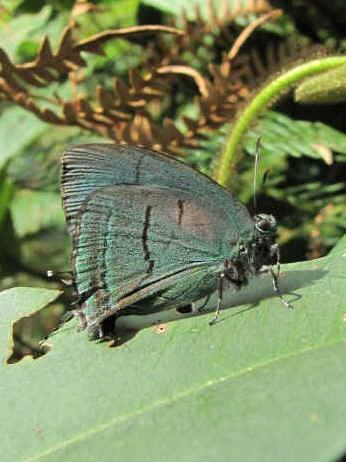
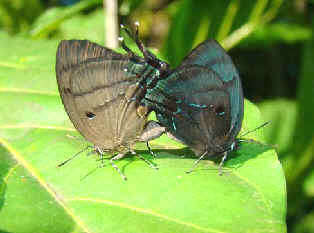
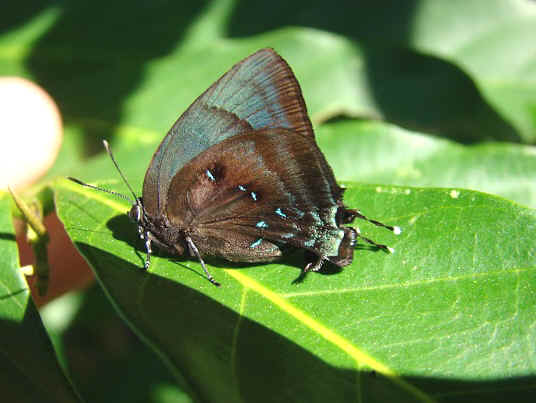

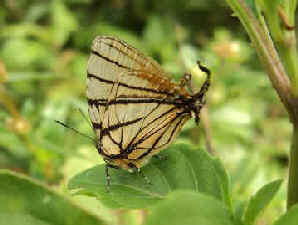

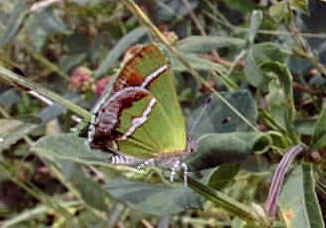
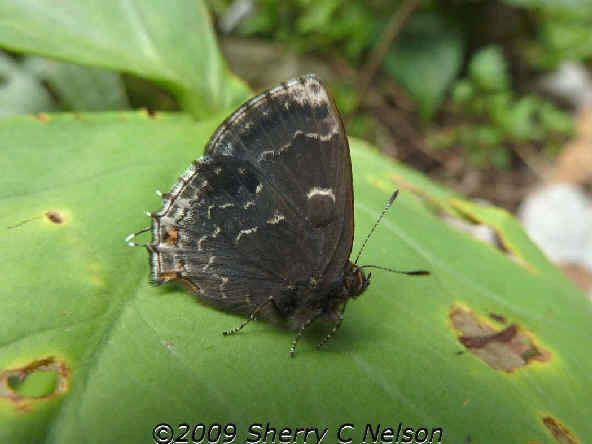
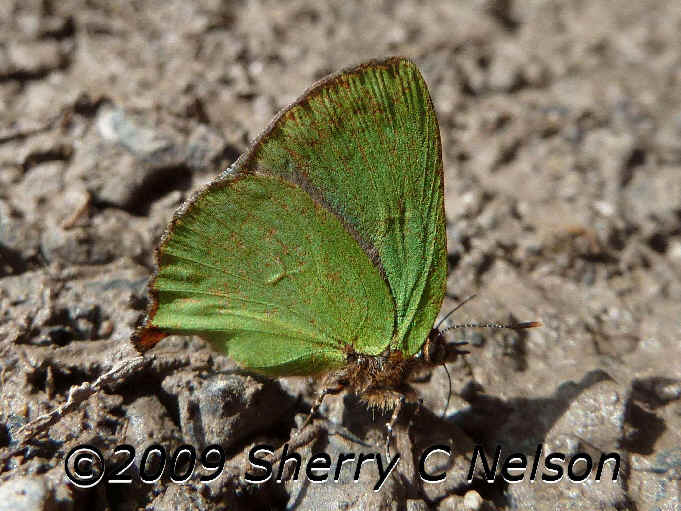
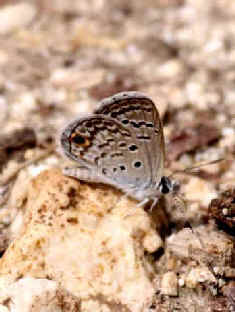
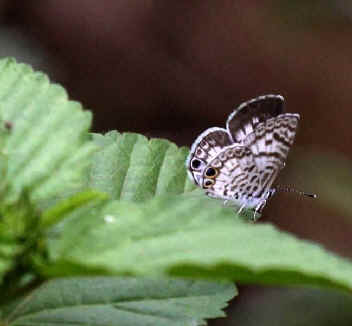
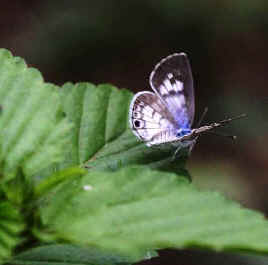
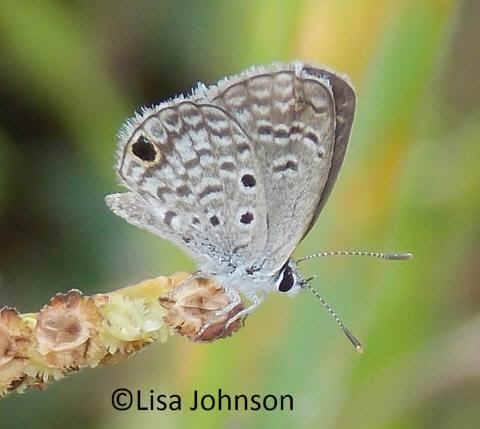
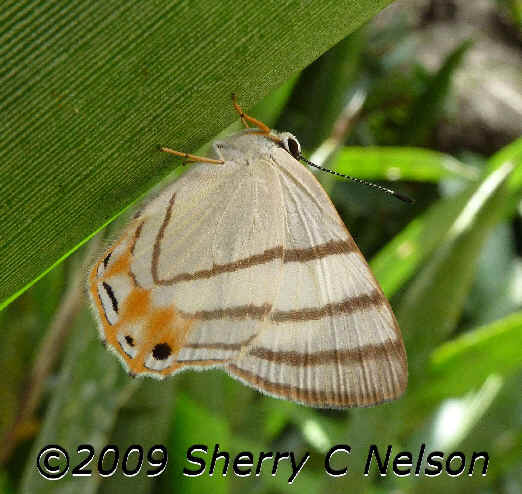
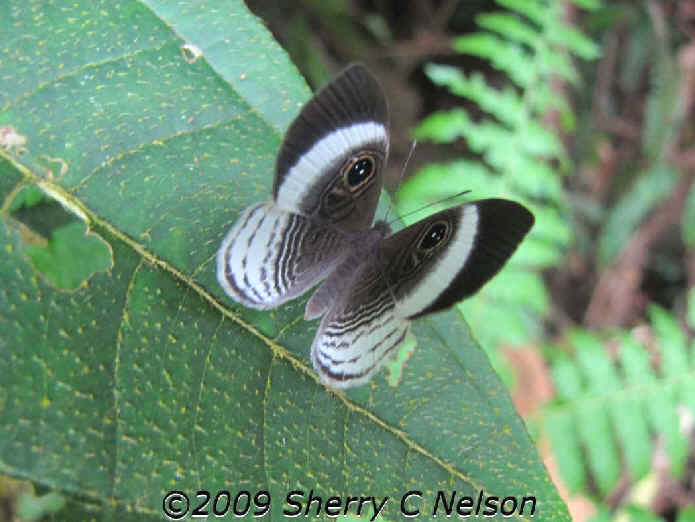
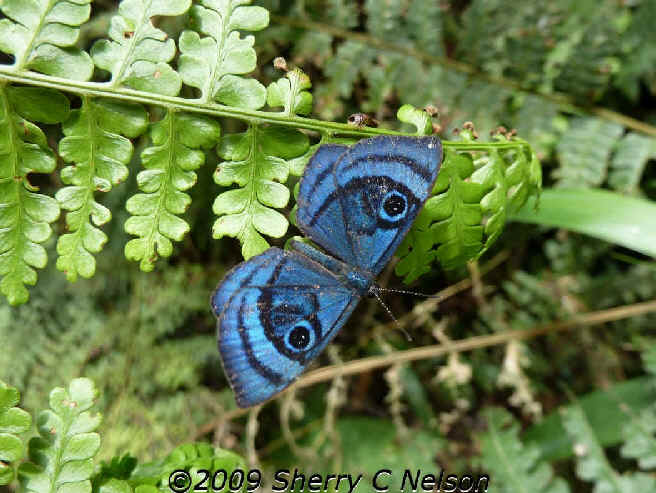
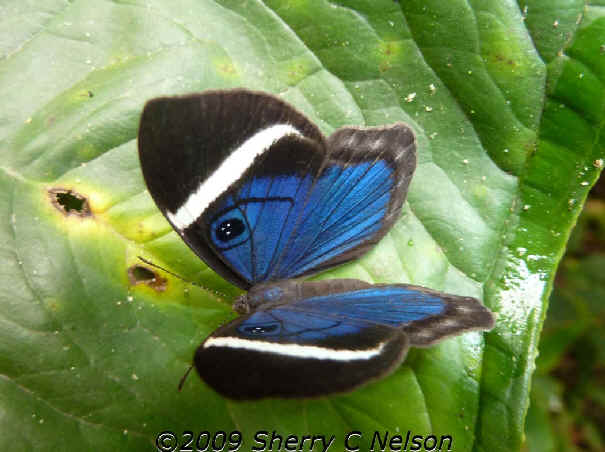
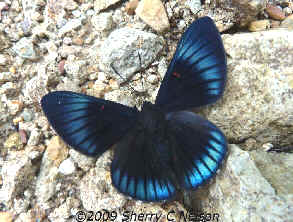
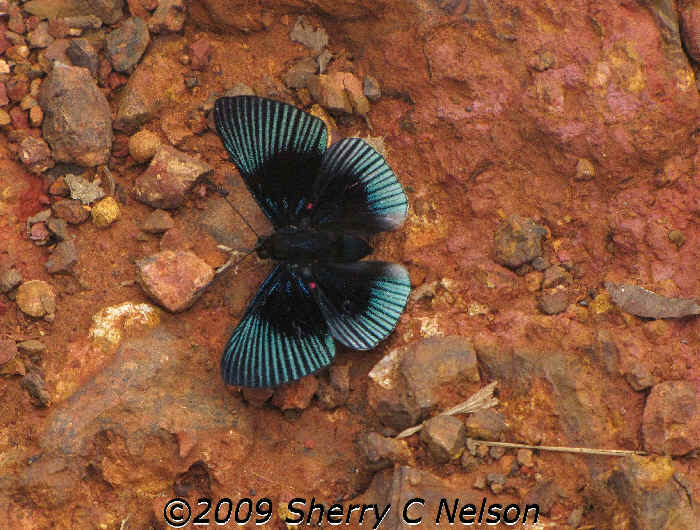
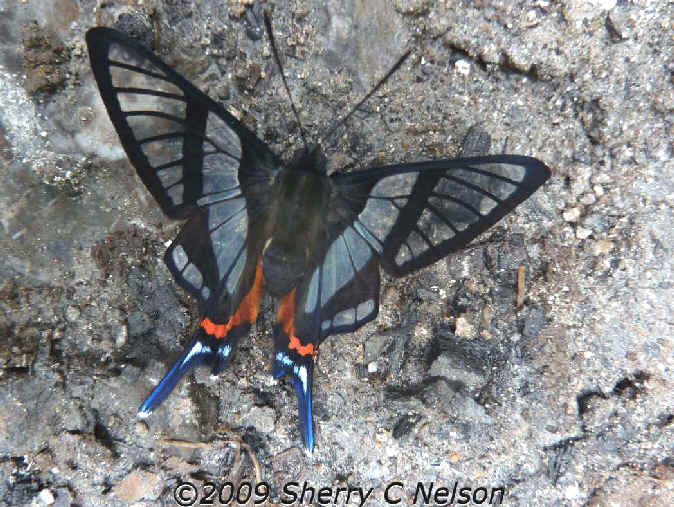
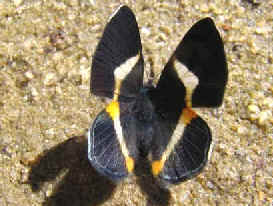
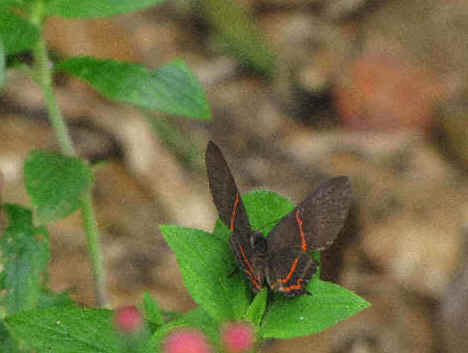

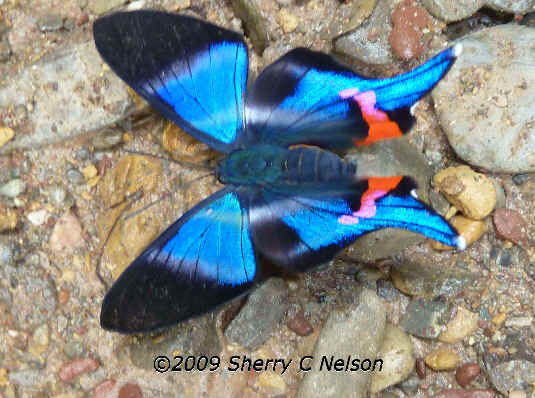


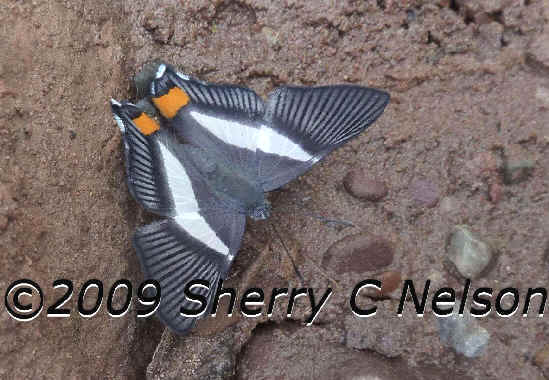
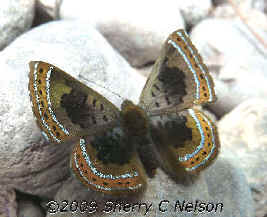

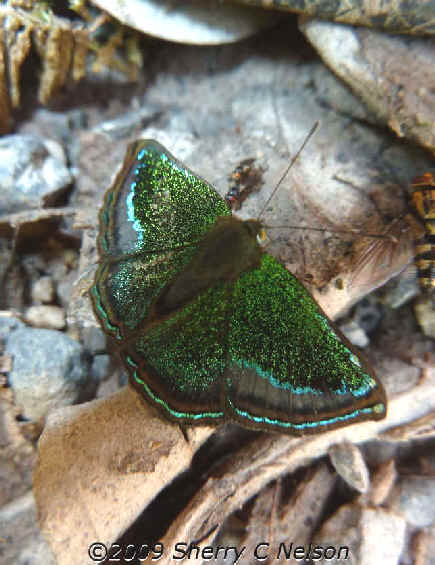
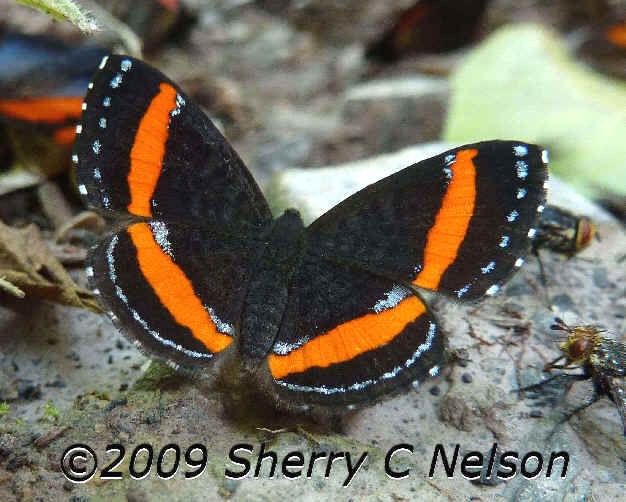

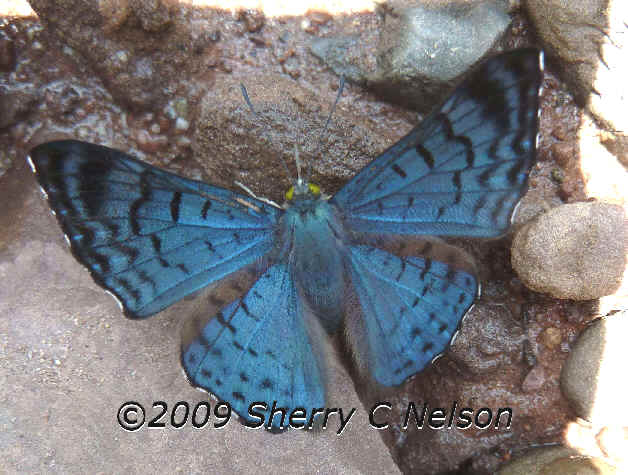
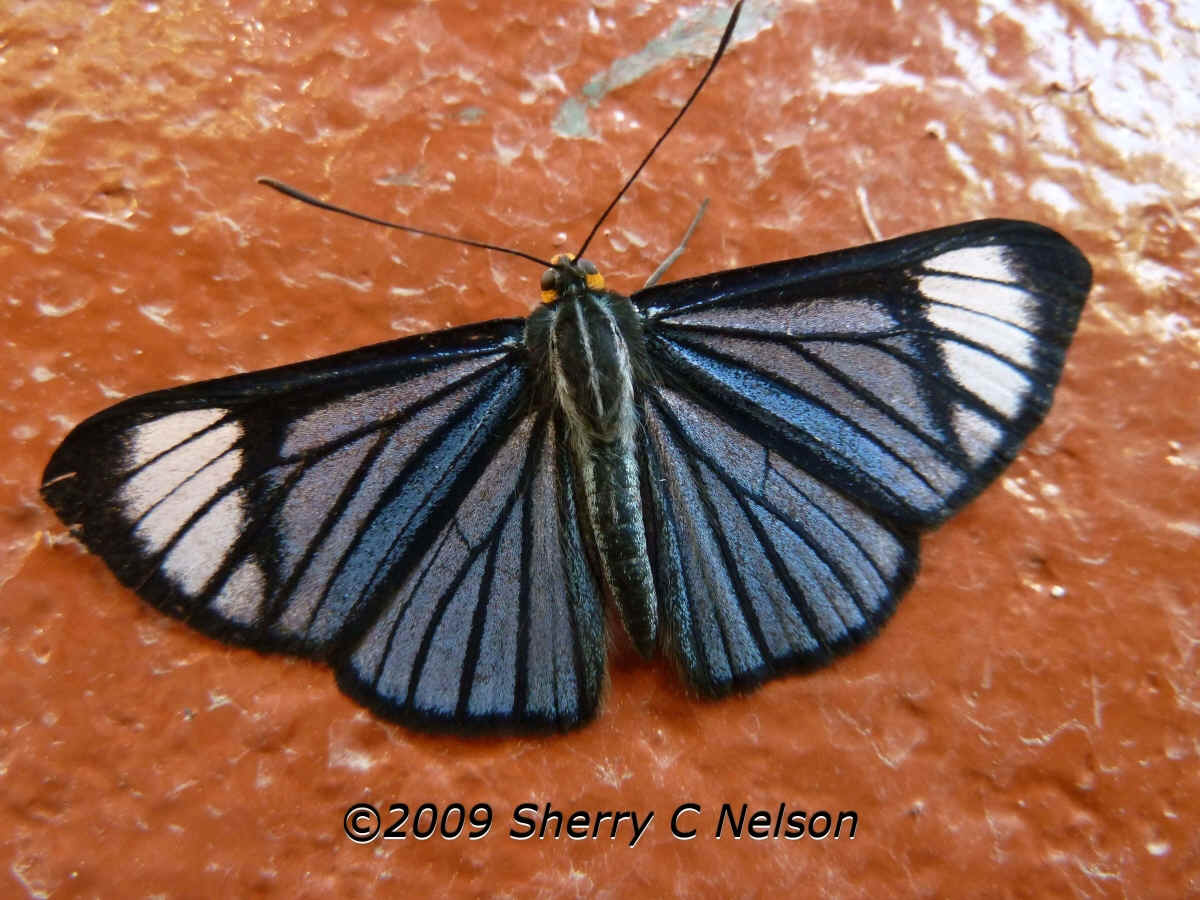


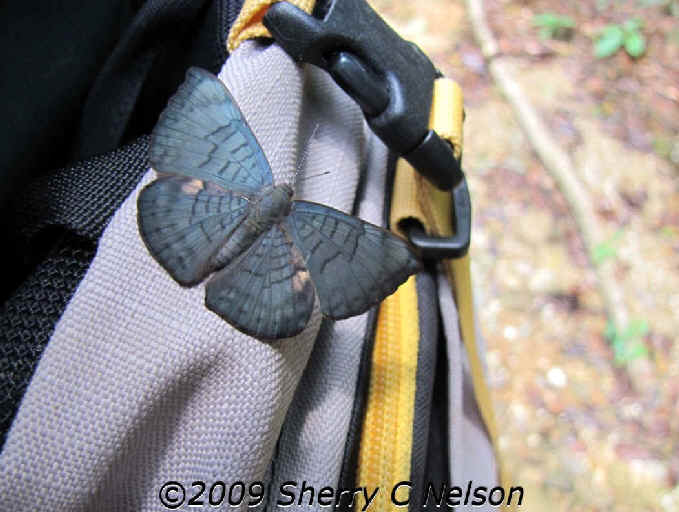
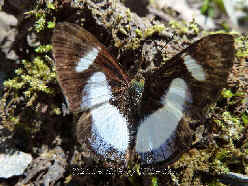
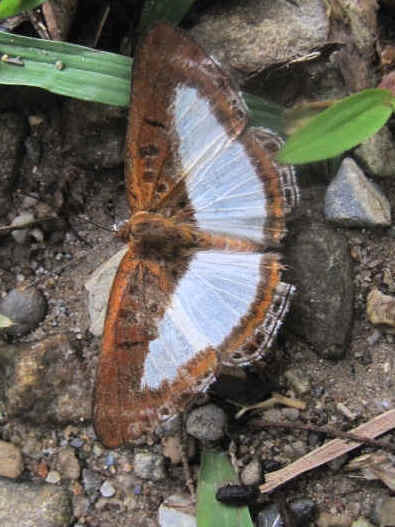
Audre notialis ______ ARne
(MM:245)